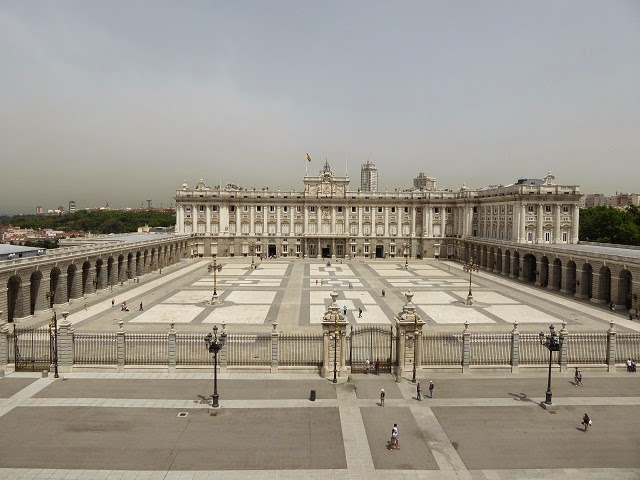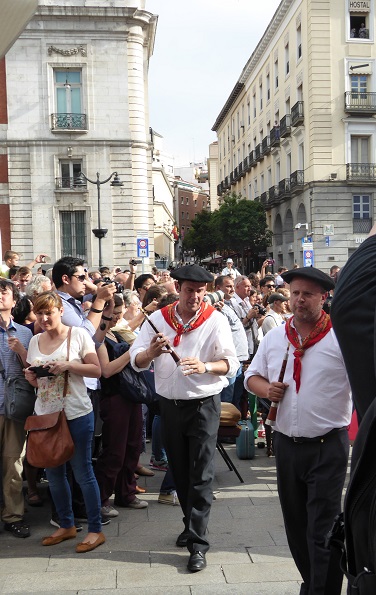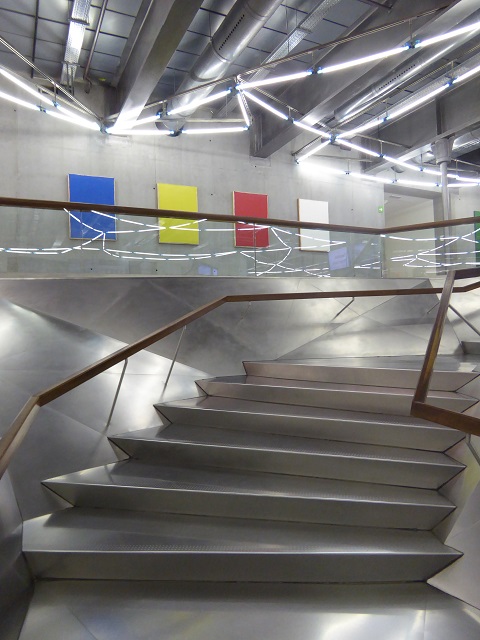PALACIO REAL DE MADRID
(Royal Palace)
SANTA MARIA LA REAL DE LA ALMUDENA
(Cathedral of Madrid)
 |
Directly opposite the Royal Palace, the Cathedral was only consecrated in 1993,
although construction began in 1883. |
 |
The extraordinary ceiling decoration was painted by Francisco "Kiko" Arguello
and was completed in 2004. Arguello also happens to be the founder of the
Neocatechumenal Way, a neo-conservative Roman Catholic religious movement.
|
SAN ISIDRO FESTIVAL
May, 2015
 |
The week-long Festival, honoring the patron saint of Madrid,begins with the
march of the "Madrid Giants and Bigheads."
|
 |
A demonstration by investors who lost their life savings in a major bank scandal
piggybacks onto the Festival parade. |
 |
To celebrate the eve of the Festival, the municipality sponsors an open-air concert in the Plaza Mayor in the center of the city, which first dates to 1619. This year it featured the singer, Paloma San Basilio and la Banda Sinfonica Municipal de Madrid (the Madrid Municipal Symphonic Band). She is apparently a very popular and seasoned, larger-than-life, singer in Spain. Inexplicably, the program was her covers of famous Broadway show tunes with a Spanish accent. Just a bit strange. Everyone seemed to be having lots of fun, although that might partially have been because of all the alcohol being consumed from the numerous bars and cafes surrounding the square. One internet source says the Plaza can hold 100,000 people. I think that might be stretching it, but there were certainly thousands and thousands of people in the standing-room-only crowd.
|
ESTACION DE MADRID ATOCHA/
MADRID PUERTA DE ATOCHA
(The Madrid Train Station)
 |
The central train station for Madrid whose new terminal was
designed by architect, Rafael Moneo in 1992. |
 |
| Second new addition to station, for the high-speed line trains. |
 |
The domed, drum-shaped pedestrian entry hall that stands at the intersection of
original and the new train station. |
(The Original - and now, adjacent - Train Station)
 |
| Alberto de Palacio Elissagne, architect with Gustav Eiffel, 1892. |
 |
Upon the construction of the new station in 1992, the original train hall became a 4000m2
tropical garden park, ringed with shops and restaurants. |
Museo Nacional Centro de Arte Reina Sofia (MNCARS)
(Sofia Museum)

 |
| The original building, a late 18th-cenutry, early 19th-century hospital by architects, Jose de Hermosilla and his successor,Francisco Sabatini, was converted into a museum in the early 1980s. In 1989, architect Ian Ritchie added the glass tower elevators that transformed the structure. |
 |
| The museum concentrates on mainly Spanish, 20th-century. |
 |
In 2005, French (star)architect, Jean Nouvel added a multi-story addition to the rear of the original building that
can best be described as a series of industrial-aesthetic buildings and terraces at various levels, some of which are set at an angle to the main axis of the museum. Above all of this hovers a pierced "floating" roof. The major sufacing material is a highly reflective colored panel that is also used on the underside of the roof. The immediate effect is sublime, even if the architecture is jus tthis side of being over-wrought, object-centered rather than people-centered, and clearly a bit vain. |
 |
| This is the underside of a new auditorium that creates a shell for a new museum cafe. |
STREET SCENES
 |
| (In the interest of full disclosure, the above is a photo of a portion of the Calle Hortaleza Building designed by Gonzalo Moure arquitectos for use as a Music School / Sport facilities / Day care center / Nursery…and, most significantly, the Madrid Architects’ Association: COAM Headquarters.) |
MUSEO NACIONAL DEL PRADO
(The Prado)
 |
(Photo by others.)
The building was designed in 1785 by the architect, Juan de Villanueva. In 2007, the museum undertook major and entirely undistinguished renovations by architect, Rafael Moneo (see, Madrid Train Station above). This entry has been abandoned.
|
 |
The new entry is below-grade at the rear of the original building (to right of photo under the concrete spandrel)
in an addition whose roof has been "greened". |
 |
The addition then tunnels its way under the street and re-appears as a newly renovated multi-level building
(the all-brick one) that is used for temporary exhibitions. Visitors cannot enter here. |
 |
Inside, half of the new entry hall is commandeered by the "Cafe Prado." (This actually
does have the feeling of a train station.) |
 |
| ...and the other half by the ticket booths and this one piece of art. |
 |
| The original entry hall, renovated as a sculpture gallery, overlooks (sort of) the new addition. |
 |
| The meeting of the old and new at the below-grade transition. |
 |
| Meanwhile, the original building continues to perform its traditional function. |
CENTRO CULTURAL CONDE DUQUE
 |
A former army barracks, the Real Cuartel de Guardias de Corps (the headquarters of the elite Royal Guard) of King Philip, designed by architect, Pedro de Ribera at the beginning of the 18th-century, has been converted into another kind of civic resource. The cultural center, completed in 2011, includes a contemporary art museum, the Museo de Arte Contemporaneo (Museum of Contemporary Art,) a public library, a state historical research library, offices for cultural institutions, etc., etc.
|
 |
| The entry courtyard shown is only one of three enormous squares within the structure. |
 |
The ground floor of one of the wings has been converted into the temporary exhibition gallery
for the museum. |
 |
| The permanent museum galleries are located in another wing on the upper floor. |
 |
| The concert hall has been inserted into another entire wing of the complex, in a space that was gutted from floor to roof. |
 |
Latin motto of the Spanish Royal Guards (from Virgil's 4th Ecologue, line 14):
"He delivers the world from terror."
|
MUSEO ABC
(ABC Museum of Drawing and Illustration)
CaixaForum
 |
Designed by Swiss architects, Herzog & de Meuron, this museum and cultural center that is
sponsored by the La Caixa bank, combines the renovation of an abandoned electrical station
with additional new floors of construction (the metal-clad portion). It was completed in 2007.
|
 |
The green wall (clinging to a neighboring building not visibly part of the museum) is by the
French landscape architect, Patrick Blanc, who has over the past few years swiftly built a
world-wide reputation for his vertical gardens. |
(...and Finally)
STREET ART
IIIIIIIIIIIIIIII
_____________________________________________
Copyright © 2015 Benjamin Clavan















































































































No comments:
Post a Comment